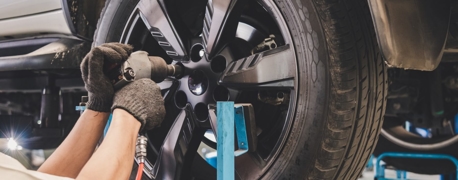15 Causes of Motorcycle Accidents

Although motorcycles make up a mere 3% of the 9 million registered vehicles on the road in the United States, they account for a disproportionate number of accidents at 14%. As one of the smallest vehicles, they can be the most difficult to see, especially in traffic, at night, or in inclement weather. According to statistics gathered by the National Highway Traffic Safety Administration (NHTSA), motorcyclists were nearly 29 times more likely than occupants of passenger vehicles to die in a crash per vehicle miles traveled in 2019. In 2020, 5,579 motorcyclists were killed in traffic accidents.
In this blog, our motorcycle accident attorneys will investigate the most common causes of accidents and how riders—and those who share the road with them—can make sure everyone gets to their destination safely.
#1. Blind Spots
As small vehicles, motorcycles can easily get lost in the blind spots of the cars and trucks around them, especially larger vehicles like 18-wheelers. It’s the responsibility of these drivers to ensure that their blind spots are clear before merging or turning, for example, but riders should also be aware of these dangers while riding.
#2. Detours
Although detours are meant to keep drivers out of harm’s way due to construction, road closures, or other hazards, unexpected road changes and signs can cause enough confusion and distraction that drivers often operate their vehicles reactively and haphazardly. Because they are so preoccupied with getting into the correct lane or going the right way, they’re typically not on the lookout for vehicles like motorcycles.
#3. Congestion
Especially in stop-and-go traffic, whether it’s caused by rush hour or holidays, drivers of passenger cars and commercial trucks are focused on getting to their destination as quickly as possible and may take their frustration out by merging haphazardly or driving more aggressively. They are also less likely to pay attention to smaller vehicles like motorcycles, which can cause devastating accidents.
#4. Poor Bike Maintenance
Motorcycles require regular maintenance, at least every 500 to 600 miles or every 6 months, whichever comes first. Especially when warmer weather comes around, and more and more bikes are getting on the road, maintenance is crucial for a safe ride.
Regular motorcycle maintenance should include:
- Tire pressure
- Oil change
- Fresh fuel
- Battery life
- Tire tread
- Fluid levels
- Cable housing check
#5. Not Following Traffic Laws
Driving laws are most often put in place for safety, so when a driver or motorcycle rider doesn’t follow them, they are putting themselves at risk. Not knowing the laws in unfamiliar states, too, can cause significant danger.
The following are traffic violations that can cause serious motorcycle accidents:
- Not using turn signals
- Passing in a no-passing zone
- Not reducing speed in a construction zone
- Driving too slow
- Speeding
#6. Drinking & Riding
As you might expect, motorcycle riders should not drink and drive, but did you know that in many states, it’s recommended not to drive with a drunk passenger on a motorcycle? Not only does this potentially fall under public intoxication laws, but a passenger should be able to support themselves on the bike, which may be impossible if they’re not sober. In 2020, 27% of motorcyclists killed were drunk at the time.
#7. Fatigue
Similar to inebriation, both driver and passenger fatigue can affect a motorcycle’s safe operation. Both drivers and passengers should be active and responsive to the road and other vehicles—fatigue can limit response times and even cause dangerous swerving.
#8. Distracted Drivers
Whether they’re rocking out to their favorite tunes, chatting with passengers, or texting while driving, distracted drivers put those who share the road with them in danger. In 2020, according to the National Highway Traffic Safety Administration (NHTSA), 3,142 people were killed in accidents caused by distracted driving.
#9. Not Wearing Required Gear
When riding on a motorcycle, the driver and passenger are exposed to the elements—not only weather, but also the dangers of the road. Protective gear is required to keep them safe from these hazards. In most states, the standard equipment includes a helmet, and in some states, eye protection is also required. In 2021, only 65% of motorcyclists used DOT-compliant helmets.
Protective gear can shield a rider from the motorcycle itself, too. Long pants can prevent burns, while closed-toe shoes can keep feet safe from the road, heated elements on the bike, and foot pegs.
#10. Road Conditions
Similar to cyclists, motorcycle riders are put at risk when roads are not kept up properly. From loose stones to potholes, grooves, and unexpected road debris, motorcycles are put at risk by poorly maintained roads.
#11. Rude Drivers
With so many vehicles on the road today, it can be difficult to predict how drivers may act. Unsafe drivers often don’t care for other’s safety or refuse to obey traffic laws, putting others at risk.
#12. Poor Visibility
Especially when riding at night or in inclement weather like rain or fog, visibility is a serious concern for motorcycle riders. Because they are already among the smallest vehicles on the road, many drivers may not notice a motorcycle, and riders may also have trouble seeing others in their path such as pedestrians, cyclists, other motorcyclists, cars, or trucks.
#13. Poor Choices
One of the most important rules about riding a motorcycle is knowing when you shouldn’t. Experienced riders may choose not to ride in the rain, for example. It’s also important to understand the limitations of your bike. As small vehicles, motorcycles may not be able to carry as much luggage as you’d like while continuing to be maneuverable.
#14. Weather
Even the most temperate day can be a dangerous time to ride. Weather plays an important role in the safety of the road, from rain to high winds and even blinding sun. Weather can impact the operation of your bike and the actions of other drivers.
#15. Lack of Experience
Just like driving, riding a motorcycle requires extensive training and the achievement of a license to be on the road. New riders, and those who are getting back on the bike after a while, are especially vulnerable. According to the NHTSA, 30% of fatal motorcycle accidents in 2019 involved riders without a valid motorcycle license.


